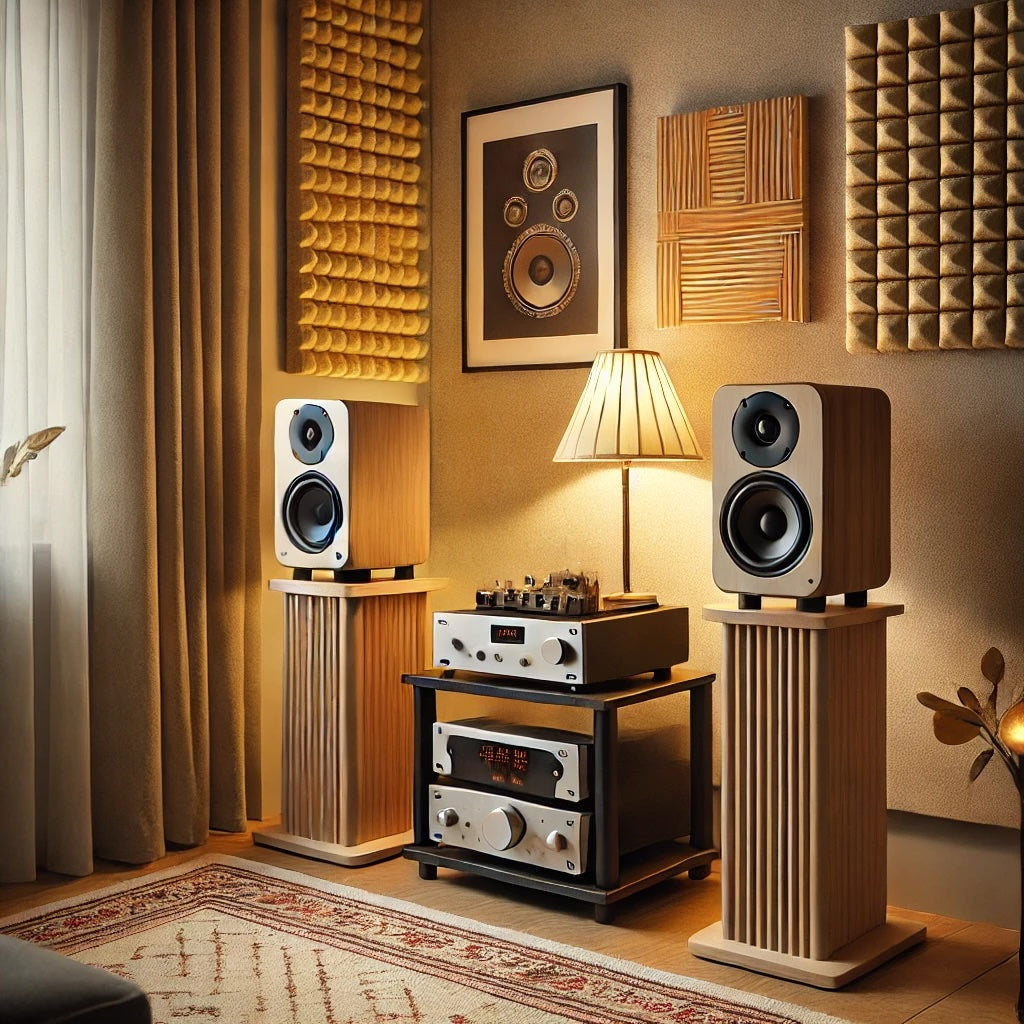Are you struggling with muddy, congested sound or lackluster performance from your two-channel audio system in a small room? Whether you’re craving clarity, balance, or that satisfying clean bass, optimizing your system to suit your space is key. Small rooms come with unique acoustic challenges, but with careful planning and a few tweaks, you can achieve stunning sound quality without breaking the bank.
Let’s dive into actionable strategies to help you make the most of your setup, even in a tight space.
1. Choose Speakers That Match Your Room Size
One of the biggest mistakes audio enthusiasts make is choosing speakers that are too large for their listening space. Large speakers with big woofers can overwhelm small rooms, creating excessive bass and muddying the sound. Instead of hearing clear music, you end up with a boomy, cluttered mess.
Why Size Matters
Speakers work by creating sound waves that interact with the space around them. In small rooms, these waves can quickly bounce off walls, floors, and ceilings, creating unwanted resonance and bass buildup. High frequencies (treble) are absorbed or reflected differently than low frequencies (bass), often resulting in an unbalanced sound profile.
Solution: Opt for Smaller, Balanced Speakers
For small rooms, bookshelf or stand-mounted speakers are usually the best choice. These speakers are designed to deliver detailed sound without overpowering the space. Look for models with smooth bass response and a balanced tonal profile.
- Example: Brands like KEF, ELAC, or Wharfedale offer excellent bookshelf speakers designed for smaller environments. Models with built-in passive radiators can provide a bit more bass extension without muddying the sound.
Placement Tips
Proper placement is just as important as speaker size. Here are a few guidelines:
- Avoid placing speakers too close to walls or corners, as this can amplify bass.
- Position speakers so that the tweeters are at ear level when you’re seated.
- Use speaker stands or isolation pads to reduce vibrations and resonance.
2. Opt for Easy-to-Drive Speakers
Not all speakers are created equal, and some require significant power to perform at their best. High-end speakers with complex designs or low sensitivity ratings can be challenging to drive, especially if your amplifier isn’t up to the task. When improperly powered, these speakers can sound thin, harsh, or even distorted.
What Are “Easy-to-Drive” Speakers?
Easy-to-drive speakers have higher sensitivity ratings (measured in dB) and lower impedance requirements. These speakers require less power to produce the same volume as lower-sensitivity models, making them ideal for small rooms and smaller amplifiers.
Why This Matters
For beginners or those on a budget, choosing easy-to-drive speakers ensures you get clean, balanced sound without having to invest in a powerful (and often expensive) amplifier.
- Example: A speaker with 90dB sensitivity will sound louder and clearer at a given power level than one with 84dB sensitivity.
Matching Speakers with Amplifiers
When selecting speakers, make sure they’re compatible with your amplifier. Check the impedance rating (ohms) and ensure your amplifier can handle the load. A mismatch can lead to poor sound quality or even damage your equipment.
3. Fine-Tune Your Setup for Balance
Even the best speakers won’t perform optimally without proper fine-tuning. Think of this as “seasoning” your sound to your taste. If your system sounds too bright, too muddy, or just not right, small adjustments can make a world of difference.
Start with Speaker Placement
Speaker placement plays a significant role in achieving balanced sound:
- The Rule of Thirds: If possible, place your speakers about one-third of the way into the room, away from walls. This minimizes reflections and creates a more natural soundstage.
- Toe-In: Slightly angling your speakers toward your listening position can improve imaging and focus.
- Symmetry: Keep your speakers equidistant from side walls and your listening position to maintain balanced sound.
Experiment with Amplifier Matching
Amplifiers have their own tonal characteristics, and pairing the right amplifier with your speakers can enhance their strengths or compensate for weaknesses. For instance:
- A warm amplifier can soften overly bright speakers.
- A neutral amplifier can provide clarity and precision for balanced sound.
Use Tone Controls and Room Correction
Many modern amplifiers include built-in tone controls or room correction tools like Dirac Live or Audyssey. These features allow you to adjust bass, treble, and midrange frequencies or even analyze your room acoustics for automatic optimization.
4. Control Bass Energy
Bass is one of the trickiest elements to manage in a small room. Too much bass can make your system sound boomy and muddy, while too little bass can leave your music feeling thin and lifeless. Striking the right balance is essential for achieving great sound.
Why Bass Gets Boomy in Small Rooms
Low-frequency sound waves are long, and in small spaces, they can reflect off walls and floors, causing them to build up and overpower the rest of the sound spectrum. This is why small rooms often struggle with excessive bass energy.
How to Tame the Bass
- Placement Matters: Keep speakers away from walls and corners to reduce bass reflections. A small adjustment in placement can significantly improve clarity.
- Add Acoustic Treatments: Bass traps and absorption panels can help manage reflections and reduce resonance.
-
Adjust Your Amplifier Settings: Many amplifiers allow you to cut or adjust bass frequencies. Reducing bass energy can clarify the mids and highs, allowing you to enjoy music at higher volumes without distortion.
5. Embrace Bookshelf Speakers
For small rooms, bookshelf speakers are often the ideal choice. They provide excellent imaging, precise detail, and a focused soundstage without the overpowering bass of larger floor-standing models.
Why Bookshelf Speakers Work Well
- Compact Design: Bookshelf speakers take up less space, making them easier to position for optimal sound.
- Tight Bass: Smaller cabinets minimize unwanted resonances, resulting in cleaner bass performance.
- Better Imaging: Because they’re smaller, bookshelf speakers can often produce a more precise soundstage, allowing you to “see” where each instrument is in the mix.
Upgrading to Larger Stand-Mounted Speakers
If you’re worried about missing out on bass, consider medium-sized stand-mounted speakers. These speakers offer larger woofers and cabinets for slightly more bass extension without compromising the benefits of a smaller form factor.
Matching Bookshelf Speakers with Amplifiers
Pairing bookshelf speakers with a robust amplifier can enhance their performance. A good amplifier will provide tight control over the bass while allowing the mids and highs to shine. Look for amplifiers with neutral or slightly warm tonal characteristics to complement the clarity of bookshelf speakers.
6. Don’t Ignore Room Acoustics
Your room is just as important as your equipment when it comes to sound quality. Even the best speakers and amplifiers can’t overcome poor room acoustics. Small rooms often have hard surfaces like walls, floors, and ceilings that reflect sound and create unwanted echoes.
Simple Acoustic Fixes
- Rugs and Curtains: Add a thick rug to the floor and heavy curtains to windows to absorb sound reflections.
- Bookshelves and Furniture: Strategically placed furniture can act as diffusers, breaking up sound waves and preventing them from bouncing around the room.
- Acoustic Panels: If you want to go a step further, consider adding acoustic panels to your walls to absorb mid and high frequencies.
Room Shape Matters
The shape of your room also impacts sound quality. For example:
- Rectangular Rooms: Position your speakers along the shorter wall for better sound dispersion.
-
Square Rooms: Be careful with speaker placement, as square rooms often amplify bass frequencies, creating uneven sound.
7. Experiment and Have Fun
The beauty of audio as a hobby is the endless opportunity for experimentation. Don’t be afraid to try different placements, equipment combinations, and acoustic treatments until you find what works best for you. Small changes can make a big difference, and the process of discovery is part of the fun.
Try These Small Tweaks
- Swap out cables to see if higher-quality options improve clarity.
- Adjust your listening position. Moving even a few inches closer or further from the speakers can dramatically change your perception of sound.
- Play with toe-in angles to refine imaging.
Final Thoughts
Creating a clean, balanced, and engaging two-channel audio system in a small room doesn’t have to be overwhelming. By choosing the right equipment, experimenting with placement, and addressing room acoustics, you can unlock the full potential of your setup.
Remember, there’s no one-size-fits-all solution. Your system should reflect your personal taste and adapt to your unique space. So, take your time, enjoy the process, and let your ears guide you toward the perfect sound.
With a bit of patience and experimentation, you’ll soon transform your small room into a haven for high-quality audio.


